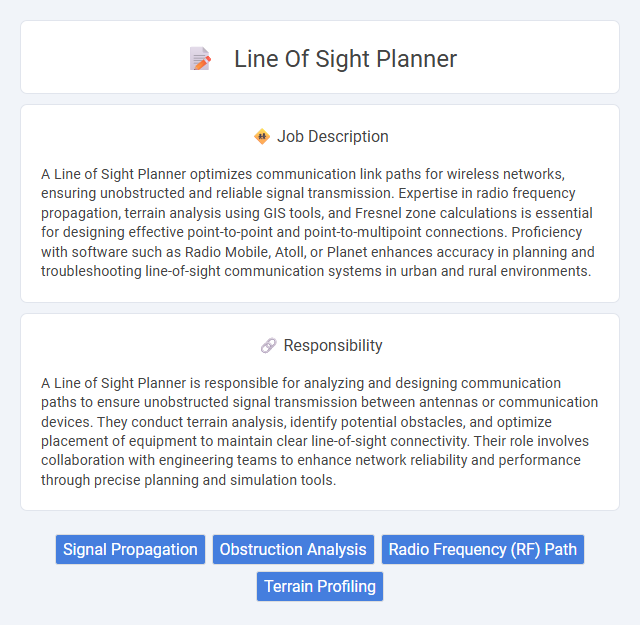
A Line of Sight Planner optimizes communication link paths for wireless networks, ensuring unobstructed and reliable signal transmission. Expertise in radio frequency propagation, terrain analysis using GIS tools, and Fresnel zone calculations is essential for designing effective point-to-point and point-to-multipoint connections. Proficiency with software such as Radio Mobile, Atoll, or Planet enhances accuracy in planning and troubleshooting line-of-sight communication systems in urban and rural environments.
Individuals with strong spatial awareness and problem-solving skills are likely to be well-suited for a Line of Sight Planner role, as the job demands precise calculation of visibility between points and understanding of environmental factors. Candidates who can maintain focus in detail-oriented tasks and are comfortable working with technical tools and data may find this position aligns with their strengths. Those who struggle with complex spatial reasoning or managing multiple analytical variables might face challenges in performing effectively in this role.
Qualification
Line of Sight Planner roles require strong expertise in telecommunications and network engineering, emphasizing proficiency in RF propagation and microwave link design. Candidates typically hold degrees in electrical engineering or related fields, alongside certifications such as Cisco Certified Network Associate (CCNA) or Certified Wireless Network Expert (CWNE). Advanced skills in GIS software, signal analysis tools, and project management are essential for optimizing network coverage and ensuring precise link alignment.
Responsibility
A Line of Sight Planner is responsible for analyzing and designing communication paths to ensure unobstructed signal transmission between antennas or communication devices. They conduct terrain analysis, identify potential obstacles, and optimize placement of equipment to maintain clear line-of-sight connectivity. Their role involves collaboration with engineering teams to enhance network reliability and performance through precise planning and simulation tools.
Benefit
Working as a Line of Sight Planner likely offers the benefit of enhancing communication network efficiency, which can improve overall project outcomes. This role probably allows professionals to develop expertise in advanced mapping and signal analysis tools, increasing their value in the telecommunications and defense industries. Employees may also experience career growth opportunities due to the specialized skills required for precise line of sight planning and optimization.
Challenge
The Line of Sight Planner role likely involves complex spatial analysis and coordination to ensure optimal visibility and communication paths, which can present significant technical challenges. This position probably requires balancing multiple environmental variables and technological constraints to maintain clear lines of sight within dynamic settings. The challenge of continuously adapting plans to evolving conditions might be a key aspect that tests problem-solving skills and precision.
Career Advancement
Line of Sight Planner roles are critical in telecommunications and defense sectors, offering pathways to senior network architect or strategic operations manager positions. Expertise in spatial analysis, signal propagation, and geographic information systems accelerates career progression by enhancing problem-solving capabilities in complex environments. Mastery of advanced planning software and cross-functional collaboration increases visibility for leadership opportunities and specialized project assignments.
Key Terms
Signal Propagation
Line of Sight Planner specializes in analyzing signal propagation to ensure unobstructed communication paths between transmitting and receiving antennas. They utilize tools such as radio frequency modeling software and terrain analysis to predict signal strength and identify potential interference or obstacles. Expertise in electromagnetic wave behavior and frequency band characteristics is crucial for optimizing wireless network performance.
Obstruction Analysis
Line of Sight Planner specializes in obstruction analysis to ensure clear signal paths in telecommunications and broadcast networks. The role involves identifying and assessing physical barriers such as buildings, trees, and terrain features that may disrupt line of sight between transmitting and receiving antennas. Utilizing advanced software and geographic data, the planner models signal propagation to optimize network performance and reliability.
Radio Frequency (RF) Path
Line of Sight Planner specializes in analyzing and optimizing Radio Frequency (RF) path propagation to ensure clear and reliable communication links. This role involves using geographic and topographic data, along with RF modeling tools, to identify potential obstructions and calculate optimal antenna placement for maximum signal strength and minimal interference. Expertise in RF path loss, Fresnel zones, and terrain profiling is essential to design efficient point-to-point wireless communication networks.
Terrain Profiling
Line of Sight Planner roles demand precision in terrain profiling to ensure effective signal transmission and reception. Utilizing advanced GIS software and digital elevation models, these professionals analyze geographic features to predict potential obstructions and optimize antenna placement. Mastery of terrain-based data interpretation enhances network reliability and minimizes signal interference in telecommunications and defense applications.
 kuljobs.com
kuljobs.com